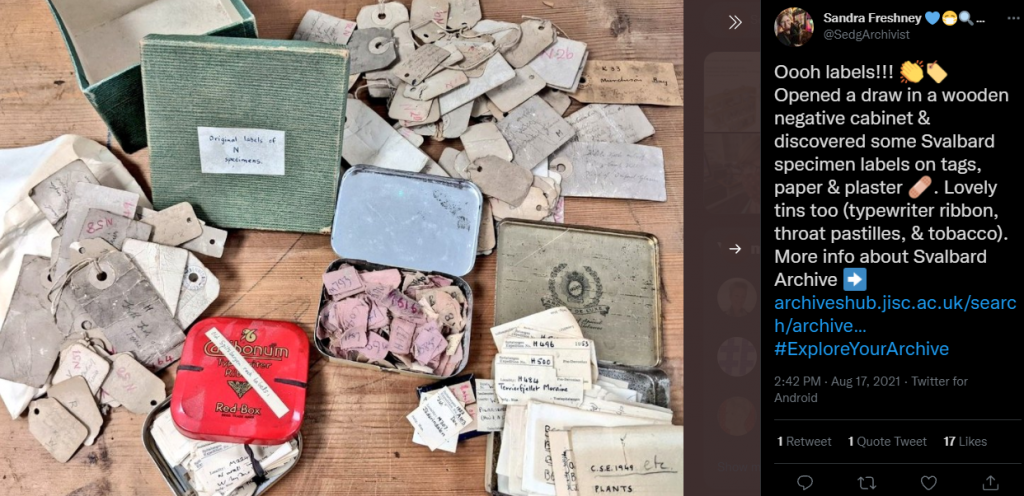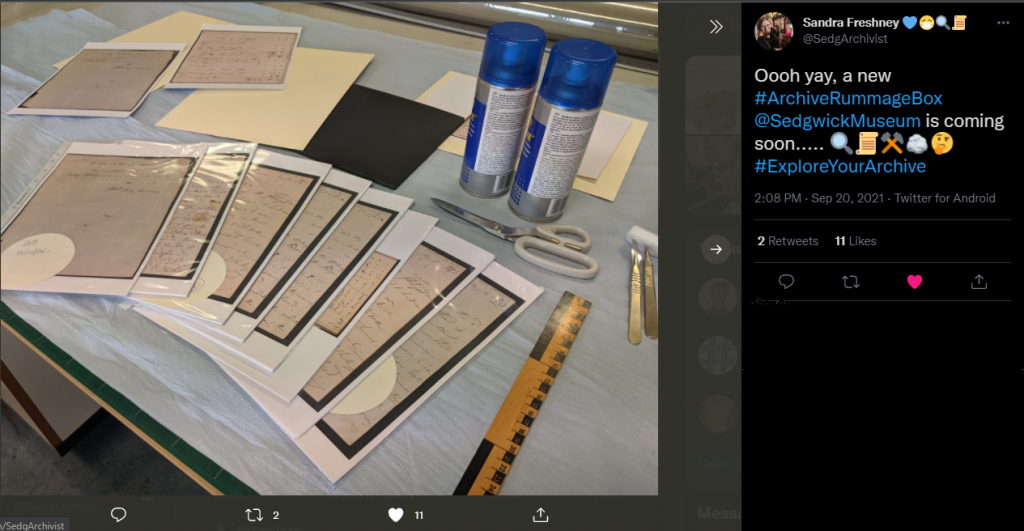PART IV of our blog series explores how the Sedgwick Museum is challenging perceptions and changing experiences, continuing with a peak into the archives.
Sandra Freshney’s work aims to bring the archive closer to the public and challenge assumptions about what geology and geologists traditionally look like. Her work includes allowing quieter voices in the department’s history to be heard. Here she gives us a greater look into the work she is doing.
Allowing quieter voices to be heard
How many items are held in the archives?

There are roughly two thousand boxes in the archive and somewhere in the region of five million documents, possibly more. The collection includes institutional records related to the museum (though that’s split with the university archives); papers of the Woodwardian Professors and curators; Earth Sciences papers connected with the Department and some of the objects in the museum as well as the Sedgwick Club, the comprehensive Cambridge Svalbard Exploration archive — we also have an art collection.
Can you highlight any interesting or surprising records that people might not know about?
One of the most fascinating archives we have is Woodward’s copy of Italian Baroque painter and geologist, Agostino Scilla’s, text ‘Vain Speculation Undeceived by Sense’ [La vana speculazione disingannata dal senso, 1670] which records Scilla’s ideas about fossils. Woodward’s copy has original pencil drawings of the fossils at the back of it. A few years ago we had the text translated to English and the drawings digitised so you can access that as a pdf through the website.
Another gem is the military medals of William Bernard Robinson King. We have his OBE for his geology work in WWI and his military cross for bravery from WWII. We also have King’s photograph album which includes images of student, Archibald Don who we discovered sent back mammoth tusks to the Museum in 1916 whilst stationed in Salonika.
The Svalbard collection includes field notebooks and thousands of negatives & photographs. It also includes some tins and boxes that have the labels from the specimens. Some of them are little pieces of plaster and the adhesive has deteriorated, so they’re a bit crunchy! It’s funny to imagine someone patting their pockets to find a label and coming up with a plaster but it was probably selected to work well in the environment at the time.

How do you acquire items that haven’t been directly left with you?
Many of the papers written by earlier Woodwardian Professors have remained in the museum, organically if you like. Otherwise, we are usually approached by someone who wants to donate a family member’s collection. For example, William Robinson King’s granddaughter got in touch with some of his documents. Another time, someone got in touch about an old album of photos that were from the Sedgwick club in the 1930s which was wonderful – it has helped fill a gap in our record. And we were recently offered the personal diary of a student who went to Svalbard in the 1950s.
Can people access the archives online?
The Archives section of the museum site allows you to explore some of the documents in more detail. The Archives Hub (https://archiveshub.jisc.ac.uk/) is a fantastic resource for exploring collections across the UK. And we are gradually adding data to ArchiveSearch which provides access to finding aids and links to digital records for the majority of archives located in the city of Cambridge.
We also use a ‘rummage box’ for events and for schools. We create facsimiles of records using foam board that visitors can then rummage through. There is one in the Whipple Library at the moment that will hopefully inspire some students with ideas for research projects. A virtual rummage box would also be fun!

Can you tell us about the Mary Anning Project?
Our curator in the 1970s sent a lot of our papers for preserving at the University Library. Because those items have been documented and it’s just up the road, it’s straightforward for me to access them. For the Mary Anning project, I was lucky to go to the University Library and sit in their Special Collections reading room with the archives, which included letters from Mary Anning to Adam Sedgwick.
Sometimes collections aren’t so well documented or aren’t digitised. For instance, we don’t have Adam Sedgwick’s letters back to Mary Anning. The transaction information we have is detailed but there isn’t that other side of their communications. Which, unusually, means that the dominant voice coming through is a woman’s voice in this instance – she was a great salesperson, you can see that in her letters. Fitting pieces of the puzzle together is fascinating.
What collections are you hoping to promote in future?
We are working to promote the collections all over the world. Hopefully, as we improve the collections data and cataloguing, people will find it easier to discover what we have.
We also want to do some work based on a display that was in the gallery in 2015 called ‘Club and Country: Geologists, the Sedgwick Club and World War I’. It gives us an opportunity to explore the Sedgwick Club ‘war list’ in more detail (detailing college & military rank in the First World War).
I’m looking forward to getting into the post WWI period – especially the 1960s and ‘70s – of the Sedgwick Club and looking into who the women were, what they did and where they went. We are also planning to continue the feminist tours we started in 2019, which highlight the lesser-known stories of trailblazing women of geology and palaeontology.
Along with all of the above, the team at the Sedgwick Museum have been expanding their range of loan boxes for schools and building summer programmes, all whilst maintaining a safe visitor experience over 2020, 2021 and into 2022. The business of the museum never rests. If you’re in Cambridge, be sure to book a visit.


